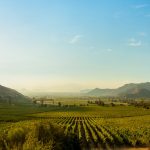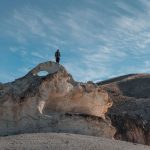We’re all bombarded by it. Every day, on Facebook, Instagram, Pinterest. In search of the mini dopamine hits we get in the form of likes on photos of ourselves, home improvement projects, kids and pets. And when we’re not focused on our own feeds, we’re seeing other people’s photos. Vacations are prime times for an onslaught of images, beach poses in the Caribbean, picnics in the shadow of the Eiffel Tower, clinking glasses at sunset on a winery trip to Napa or Bordeaux.
Thanks to social media, much of the time, we can predict the types of photos we’ll see from friends’ vacations before they even leave for their trip. While they’re still deciding which shoes to take and packing suitcases, we can already imagine the selfies, the group poses, the drinks, smiles in front of bucket list-worthy landmarks.
And it starts to affect us, too. When going to a place that is a known entity, it’s almost unavoidable to find oneself taking the same photos in the same places, with the same poses. Holding up (or leaning against) the tower of Pisa. Pinching the sunset between two fingers. Running far into the distance on the Salar de Uyuni (Uyuni salt flats) to appear to fit in a pot or pan, or jumping out of a bottle. Once, for a project I was working on, I set out to find photos of people with their arms spread wide, a gesture common to travelers as if to say, “I did it” or perhaps “the world is this big.” In minutes, I had thousands of photos to choose from.
But what happens if you just decide to go off script? No social media. Days off-grid. A place you have no frame of reference for. Where would you go? What would you find yourself doing?
Earlier this year, we went off grid for a scouting trip to deep, pristine Patagonia, near a river, lake and park called Jeinimeni (YEN-ee-MEN-ee). This is one of the most untouched parts of deepest Patagonia, across Lago General Carrera (Chile’s largest lake, which it shares with Argentina) from the Carretera Austral. Farthest Aysén in its most natural form, in a quirky microclimate that shows all four seasons in one day, but tends towards dry winds that blow across the pampa grass. We camped in a protected valley between two mesetas, along the Río Jeinimeni. The river carves out the only highway anywhere near by, this one traveled mostly by brown and rainbow trout to spawn after a year in the frigid, nearly 600 meter-deep waters of the vast Lago General Carrera to which the river flows.
Enter to win two all-expenses paid spots on our 2019 Outpost Patagonia trekking trip: The Great Crua Outpost Escape
On our trip, there was nothing prescribed, nothing expected, and no easy way to let the world know what we were up to while we were there (though there were emergency satellite radios onsite). So what did we do? Everyplace was just as photogenic as anywhere else, and there was not a single box to be checked. What does a group of people get up to when everyone’s on their own, self-defined adventure, and social media has nothing at all to say about it?
Here’s what we found:
With it burbling nearby, people gravitated to the river, just to take a peek. For no other reason than to watch the water course down the slight incline, tumbling over rocks as it went. Or to cup their hands and drink the water fresh from its source. One person went in for a full frigid dunk, and for a few more, wading was enough immersion in this swift, translucent turquoise river.
Conversations went around and around, meandering as we thought of new topics. And it we didn’t know the answer to something, no one could ask Google (or Siri) to find the answer. We just kept puzzling, debating and talking. We made promises to look things up later that would probably go unkept.
We found that barba del viejo, or Spanish moss made a great fire starter one night when it occurred to us after dinner that we hadn’t yet made a campfire and set out to remedy that. With just the light of a few headlamps, and after building a quick rock circle, we easily built a fire in a few minutes, by the shores of this same river, and later watched the sparks fly up to the sky, joining the stars ever so briefly as pinpricks of light against the jet-black sky.
We surmised that Patagonian hares are mostly nocturnal, and run across the roads whenever they feel like it. However, upon seeing the headlights of our vehicle one night on the way back from a hike, they seemed confused, and ran ahead of us for minutes at a time before finally peeling off into the nearby vegetation. This led to a discussion about the difference between rabbits and hares, and the Chilean expression “pasar gato por liebre” which means literally “to pass off a cat as a hare” but means more generally, “to trick someone.”
With no real schedule to keep, sleep came deep and early, and even the expansive Patagonian sky and our cozy campfire and glasses of glinting Chilean wine couldn’t keep us awake for long after night settled in.
Early morning light reminded us of the natural rhythms of the day, and nobody had to set an alarm to remember to wake up for steaming hot coffee and a warm breakfast.
We were always connected with what was going on around us. Nobody had to tell anyone else when a condor was passing overhead, or when a rainbow appeared. We were all present right then and there, with the environment, and with each other. There were no distractions.
It made us ponder the lack of places in the worlds where you can go to get this kind of double disconnection, free of the burden of knowing the answer to every question, and of the requirement to take certain photos, or do specific things.
After four days, we were left with one important question: Did we miss social media, that connection, that direction that tells us where to go and what to do while we were there?
In short: No.
In the end, the only thing we really missed was another few days of digital detox.

